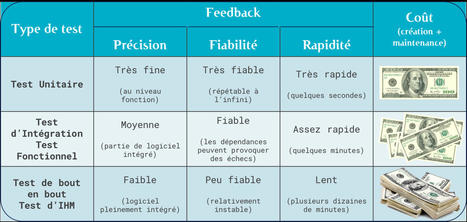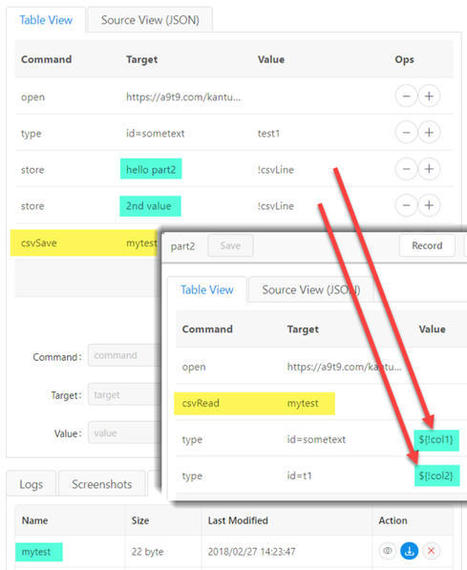 Your new post is loading...
 Your new post is loading...

|
Scooped by
Mickael Ruau
January 18, 2022 2:13 AM
|
When most of our efforts are focused on automation at the UI level, the focus is on finding bugs, whereas, with the agile pyramid, the idea is to prevent them.

|
Scooped by
Mickael Ruau
January 13, 2022 1:08 AM
|
Ham Vocke summarises the purpose of the test automation pyramid thus:
Your best bet is to remember two things from Cohn's original test pyramid:
Write tests with different granularity
The more high-level you get the fewer tests you should have

|
Scooped by
Mickael Ruau
November 29, 2021 12:04 AM
|
Here are some of the patterns that an organization can follow when applying test automation:
Pyramid Testing
When following the testing pyramid, there will be three automated test levels coming in before you get to the manual tests.
Automated Unit Tests
This level would be the starting point at the bottom of the pyramid. It involves a lot of test situations. These would be done separately, which shortens the execution time per block of the application code.
You get to see how the software behaves under different circumstances, try valid and invalid inputs, and also discover any unexpected behavior. Here, you can get a lot of feedback quickly.
Automated Integration Tests
In this next level, you try scenarios that involve different code components. The focus is on how these components work together and whether every call and response is spot on.
You also won’t have to run many test scenarios. At this level, things may move a bit slower since you’re mainly examining the intercommunication aspect. These test scenarios would cover APIs, methods, classes, etc.
Automated UI Tests
This would be the third level, and would also be of an end-to-end nature. You test an application with the integrations running and emulate real-life user interactions. This level would have tests running much slower since you’re testing more elaborate scenarios from start to end.
You’ll have fewer tests, covering major features, happy paths, and more. You get to discover how several components work together when needed in a typical use case.
The Ice Cream Cone (Anti-Pattern)
ice cream cone pattern test
In this pattern, the testing pyramid is inverted, so to speak. This means that a lot more of the QA team’s efforts are sucked away from automating unit tests. The same will happen for the other testing levels, though it might be to a lesser extent.
Nevertheless, the result is most of the testing is being done manually. Automated tests will largely be at UI/end-to-end tests level, and to some extent, the integration tests too. The result is a team that is stretched thin with these upper test levels. You’ll have fewer automated unit tests and move much slower in this aspect.
You may also have bugs and other random issues constantly trickling down from the manual tests, but not always being caught on time. In an agile environment, demanding frequent releases, you can’t thoroughly respond and make the necessary changes when unit tests are limited. You won’t be able to strike a decent balance between delivery speed and remainder flaws on your next release.
The Cupcake (Anti-Pattern)
Here, there’s a team for development, manual testing, and automated testing. They all work separately and each team tries to cover as many scenarios at each test level as possible. The problem is, with minimal communication, a lot of time can be wasted as teams have massive overlap in the scenarios tested.
And while there might be more automated UI and integration tests, unit tests still lag behind and there are more hands on deck for manual testing.

|
Scooped by
Mickael Ruau
October 29, 2021 10:44 AM
|
The overabundance of benefits of codeless testing tools outweigh the negative aspects of automation testing. They eventually save significant expenses and time in coding functionalities and convey quality through favorable test coverage. However, these tools need more documentation, features, and modularity. In summary, software testers prefer codeless test automation as a critical component when it comes to the Agile development procedure. This wouldn’t completely replace manual automation testing, but would accelerate their work. It is still maturing with its unique advantages and requirements in 2021 and complements the picture’s whole automation tests.

|
Scooped by
Mickael Ruau
October 29, 2021 8:57 AM
|
Your dynamic application needs test automation that keeps pace. Testim’s fast authoring with code flexibility boosts coverage, AI-powered stability slashes maintenance, and TestOps helps scale your team and testing efficiently.

|
Scooped by
Mickael Ruau
September 16, 2021 5:35 AM
|
Au delà d’une simple démarche d’automatisations des tests, il faut percevoir les spécifications exécutables comme une véritable opportunité de rapprocher les populations techniques et fonctionnelles autour d’une vision partagée et non ambiguë du produit logiciel. Un exemple de spécifications exécutables venant d'être exécutées et en succès. On rencontre cependant des limites lorsqu’il s’agit de tester des applications dont une part importante de la valeur réside dans la présentation et la restitution de l’information et pour lesquelles tester l’IHM est primordial. Il est alors possible de compléter l’outil en l’intégrant avec un outil comme Selenium ou Canoo. Il suffit d’écrire une fixture « passe-plat » permettant de piloter ces outils depuis des pages de spécifications exécutables ; mais alors gare à l’effet « usine à gaz » … Mix entre les approches spécifications exécutables et tests d'IHM

|
Scooped by
Mickael Ruau
August 3, 2021 1:02 AM
|
Les antipatrons des tests automatisés représentent les mauvaises pratiques courantes. Découvrez les et apprenez à les éviter !

|
Rescooped by
Mickael Ruau
from Time to Learn
June 28, 2021 7:39 AM
|
Automations that keep humans in the loop so you can scale even the most complex, manual processes
Via Frédéric DEBAILLEUL

|
Scooped by
Mickael Ruau
March 12, 2021 9:08 AM
|
It is clear that "building our own testing framework" can be an obvious trap. It's best to check first some available options based on ope

|
Scooped by
Mickael Ruau
March 11, 2021 2:01 AM
|
A test-automation framework is a set of best practices, common tools, and libraries that help quality-assurance testers assess the functionality, security, usability, and accessibility of multiple web and mobile applications. In a "quick-click" digital world, we're accustomed to fulfilling our needs in a jiffy. This is one reason why the software market is flooded with hundreds of test-automation frameworks.

|
Scooped by
Mickael Ruau
March 8, 2021 1:56 AM
|
Don't waste time creating your own test automation framework. One of these existing tools and frameworks is likely up to the job.

|
Scooped by
Mickael Ruau
March 4, 2021 9:08 AM
|
Selenium protocol implementations applied to VMs, Docker, Kubernetes, and the cloud

|
Scooped by
Mickael Ruau
January 13, 2021 3:56 AM
|
Bien souvent, le bon fonctionnement de notre application métier est couverte par des tests unitaires. Cependant, lorsqu’on travaille sur un projet web, il n’est pas évident de vérifier le comportement des web services que l’on expose. Dans cet article je vais vous présenter SoapUI. Développé par SmartBear Software, cette application Java open source sous licence EUPL permet de manipuler des requêtes SOAP et REST allant de la simple injection de requête jusqu’à la mise en place de tests de charge.
|

|
Scooped by
Mickael Ruau
January 17, 2022 1:12 AM
|
Let's recap!
The test pyramid provides a pattern to help you write tests which give you confidence in your code as you make changes.
Test automation reduces the need for manual checks and when done right, can give you the confidence to fully automate the release of your software.
Unit tests check classes quickly and thoroughly to make sure they keep their promises.
Integration tests check that the classes and parts of your application which need to work together, do so by collaborating as expected.
End-to-end tests check that users would be able to solve their problems by using your app when it’s switched on. For a web application, you’d automate this with code which pretends to be the user clicking about within the user interface.

|
Scooped by
Mickael Ruau
January 12, 2022 1:06 AM
|
Even before the ascendancy of agile methodologies like Scrum, we knew we should automate our tests. But we didn’t. Automated tests were considered expensive to write and were often written months, or in some cases years, after a feature had been programmed. One reason teams found it difficult to write tests sooner was because they were automating at the wrong level. An effective test automation strategy calls for automating tests at three different levels, as shown in the figure below, which depicts the test automation pyramid.

|
Scooped by
Mickael Ruau
November 18, 2021 12:16 AM
|
The untested code gap kills productivity and predictability. We don’t choose where the bugs go making them easy to find; they choose their hiding places, and have no mercy on us. They flare up and put teams into fire fighting mode.
Are we are beat? Do we have to put up with buggy products and long test and fix cycles? No, we do not! We must accept that a product test strategy based on manual test is unsustainable. Unsustainable systems eventually collapse. We can’t afford not to automate much of your software test.

|
Scooped by
Mickael Ruau
October 29, 2021 9:00 AM
|
Within DevOps culture, quality has become the shared responsibility of all team members who often gravitate towards applying test automation to briskly ship code changes, receive feedback, and tweak solutions to perfection.
However, implementing it in DevOps may be a tricky task. To embrace automation with confidence, companies may focus on the following best practices:
Do engage right-skilled specialists.
Do select a fit-for-purpose toolkit.
Do continuously maintain test automation suites.
Do focus on metrics to monitor progress.
Do care of test documentation and reporting.
At the same time, QA teams can succeed faster by avoiding common mistakes and:
Not overdoing DevOps automation.
Not eliminating manual testing completely.
Not following false economy.
Not starting with automating voluminous tasks.
By following these rules, organizations can guarantee a pervasive quality assurance process, accelerate product delivery, and reduce operational costs.

|
Scooped by
Mickael Ruau
October 26, 2021 4:35 AM
|
Discover the importance of agile test automation in agile methodologies, plus how to apply and maximize the productivity of a QA team.

|
Scooped by
Mickael Ruau
September 16, 2021 4:36 AM
|
Parfois, on décide de tester, on arrive à convaincre les “hautes sphères” du bénéfice et qu’il faut y consacrer du temps (et donc de l’argent), mais : - “Les test unitaires, on n’y arrivera pas, notre code est trop complexe” (trop couplé)
- “Les tests d’intégration, c’est compliqué à mettre en place, autant vouloir déployer l’application au complet.”
- “Le mieux, ça serait quand même d’avoir des tests proches de ce que fait notre utilisateur ! Et ça sera plus simple à tester.”
Et nous voilà partis pour déployer l’artillerie lourde : les tests de bout en bout (généralement des tests d’interface graphique type Selenium): - “Ça va être génial ! On va valider toute l’application en quelques tests, on pourra même montrer les rapports au métier et aux testeurs (pour peu qu’on mette du Cucumber ou du Serenity). Ils vont nous adorer ????.”
Après quelques semaines / mois, on se rend compte que ce n’était peut-être pas la meilleure idée qu’on ait eue : - les tests sont lents: “4h pour 150 tests”,
- échouent par intermittence : “Pourquoi c’est rouge ? Probablement Selenium, relance pour voir…”,
- mais pire que tout, avoir un environnement opérationnel complet et des jeux de données stables relève du casse-tête, voire de la mission impossible ????.
On investit d’autant plus que l’on se dit qu’il ne doit pas manquer grand-chose et que ce serait dommage de tout jeter maintenant. Et effectivement, on peut améliorer les choses, mais à quel prix ? Et pour combien de temps ?! Globalement la stratégie de tests “en boîte noire” n’est ni des plus efficaces, ni très rentable. J’en entends plus d’un sourire (jaune) en lisant cela, mais rassurez-vous : vous n’êtes pas seuls… Stratégie de tests Avant de vous parler de la sempiternelle pyramide des tests, rappelons quelques critères qu’il est important d’évaluer dès lors que l’on réfléchit à une stratégie de tests. Afin de lever une ambiguïté trop courante, précisons que nous parlons dans cet article de tests automatisés.

|
Scooped by
Mickael Ruau
July 8, 2021 1:26 AM
|
Assurer la qualité des microservices grâce à des tests de bout en bout peut entrer en conflit avec l'intégration et la publication rapides de composants logiciels grâce à un pipeline CI/CD automatisé. Si un test de bout en bout échoue, les pipelines CI/CD de tous les microservices impliqués sont bloqués jusqu'à ce que le problème provoquant l'échec du test soit résolu.

|
Scooped by
Mickael Ruau
April 21, 2021 10:47 AM
|
Common automation testing challenges range from a lack of skilled resources or knowledge to identify the right methods and tools to changing software requirements.

|
Scooped by
Mickael Ruau
March 12, 2021 2:09 AM
|
SOA testing helps organizations to address multiple aspects of service quality across multiple SOA service implementations.

|
Scooped by
Mickael Ruau
March 9, 2021 1:59 AM
|
Les tests d'automatisation des applications sont plus faciles avec les outils suivants. Mais avant cela ... Qu'est-ce que les tests d'automatisation? Les tests d'automatisation sont le logiciel

|
Scooped by
Mickael Ruau
March 5, 2021 1:53 AM
|
AI-powered Visual Web Automation UI.Vision RPA's image and text recognition allow you to write automated visual tests with UI.Vision RPA - this makes UI.Vision RPA the first and only Chrome and Firefox extension (and Selenium IDE) that has "�� eyes". For more information please see visual UI Testing and the XClick command. AI-powered Visual Desktop Automation UI.Vision RPA can not only see and automate everything inside the web browser. The same image and text recognition technology can automate your desktop as well (Robotic Process Automation, RPA). For more information please see Desktop Automation and the XClick command.

|
Scooped by
Mickael Ruau
January 13, 2021 3:57 AM
|
Tutoriel sur les tests fonctionnels de services web avec SOAP-UI
|
 Your new post is loading...
Your new post is loading...
 Your new post is loading...
Your new post is loading...





























